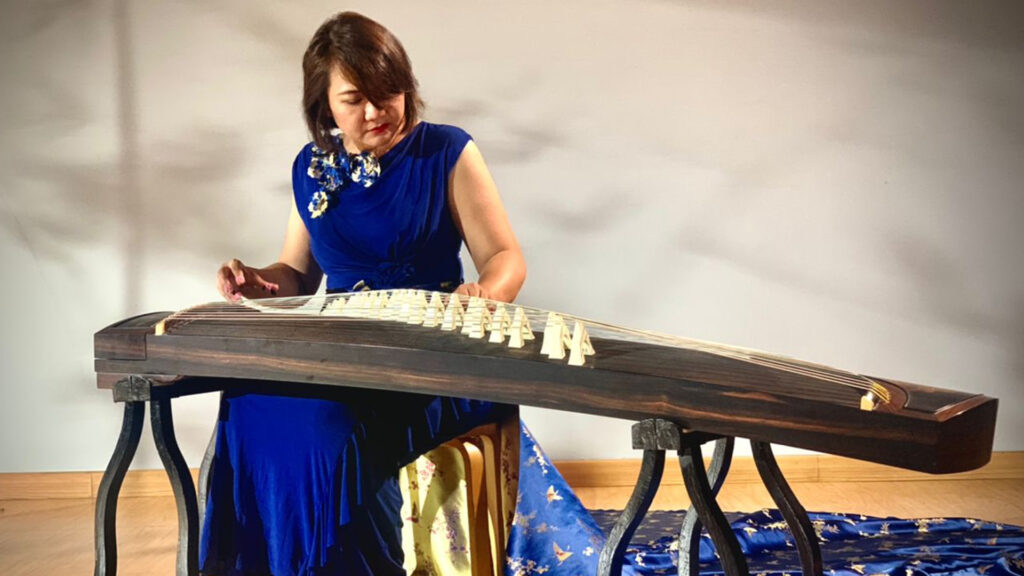TINGKAP PROJECT
HAN PALACE AUTUMN MOON ON GUZHENG
Han Palace Autumn Moon on Guzheng
by Loretta Tan
“Han Palace Autumn Moon” can be said to be Loretta’s entry-level zheng music piece. Her learning experience of repeatedly listening to the recordings of the Shandong zheng master Zhao Yuzhai (1923-1999) still remains fresh in her memory. When she began to formally learn how to play this piece, her original main teachers focused more on using pressure techniques to express the music, such as using the thumb’s small joint for the “support and chop” technique and “big rubbing” to emphasize its outstanding sound. The thumb’s “chop” combined with “double chops”, “ascending glissandos”, and “index finger rebounds” are all commonly used techniques to express the Shandong zheng style. In terms of applying the “breathing technique”, most teachers are accustomed to using one breath to play a phrase, but Loretta doesn’t necessarily agree.

During years of repeated learning and exploration, she found that adding a breath at certain points can make the expression stronger, rather than relying solely on “big breaths”. She believes that “big breaths” express the overall shape of the music, including its lightness and heaviness, while “pointed breaths” can be used even on a single note to enhance the musical charm. With an understanding of the “breathing technique”, the related “pressure techniques” then become meaningful in the music. For example, she would place a breath on the “big rubbing” with a quick “ascending glissando” to demonstrate a straightforward character trait, while a gentle “descending glissando” can express a woman’s delicate and gentle heart.
“Han Palace Autumn Moon” is an eight-part piece, which means it has eight phrases, each with eight measures. Usually, four extra measures are added to the fifth phrase, which means “eight boards”. The emotional expression of the phrases is constantly repeated. Previously, Loretta played this piece with a consistent melancholic emotion throughout, but as she aged, her understanding of the music became less flat and single-minded. She now feels that at the beginning of the piece, one should bring out an irreversible fate and a sense of helplessness. With the intensity of the playing and the insertion of breathing points, as one plays the fifth and sixth phrases, the layered emotions interweave until the end, evoking a seemingly weak but deeply determined palace lady’s sadness and helplessness, as well as a strong longing and yearning for love.
Loretta feels that the protagonist of the music is actually very strong and determined, and the style of playing is quite domineering. Many people may feel that this piece is more feminine, melancholic, and sorrowful, but her interpretation is based on a Shandong man’s perspective, with more expression of the masculine emotions of women, without appearing too soft and weak.
漢宮秋月》可以說是慧如的入門箏曲,對當時反復聆聽山東箏派宗師趙玉齋(1923-1999)的錄音的學習經歷至今仍然記憶猶新。在正式開始學習彈奏此曲時,原主課老師們比較側重於彈壓技法來表現,例如拇指小關節的“托劈法”和“大搓”來強調其突出音,拇指的“劈”加上“雙劈”、“上滑音”、“食指反彈”,這些都是常用來表現山東箏派風格的技法。在“呼吸法”的運用上,一般老師教學都習慣於用一次呼吸彈奏來處理一段樂句,慧如覺得不一定是這樣的。
在多年的反復學習探索的過程中,她發現“頓點”的時候配,上呼吸,表達會更強烈一些,而不全然是“大呼吸”來掌握。她認為 “大呼吸”所表現的是音樂中輕重緩急的大輪廓,而“點呼吸”往往運用在哪怕是“一粒音”上,都能夠提高音樂上韻味。在理解了“呼吸法”的前提下,相關的“彈壓技法”就顯得其在樂曲的意義之所在了。打個比方,她會把呼吸點放在“大搓”的“劈”加上快速的“上滑”,來展現一個直爽的性格特點,而委婉的“下滑”卻能表現女性心細溫婉。
《漢宮秋月》屬於八段體,俗話說就是八個樂句,每個樂句有八個小節,一般上在第五個樂句裡面會多出四個小節,就是八個板的意思。每當彈奏此段落的時候,樂句的情緒是不斷的反復疊加的。以前慧如彈奏此曲是由始至終貫穿幽怨的情緒,隨著年紀的積累,所理解的樂曲表達就沒那平面且單一了。她會覺得開始彈奏時,應該帶出一個不可逆的宿命和無奈的情緒。隨著彈奏的力度和呼吸點的切入,每彈奏到最後的第五第六句之時,層層疊疊的情緒交織到最後,會感覺到一個看似柔弱卻信念堅定宮女內心無比的惆悵與無奈,也徹底的流露出對愛情的強烈渴望與嚮往。
慧如越覺得樂曲的主人公其實是很堅強、很有毅力的,所彈奏風格也是比較霸氣的。很多人會覺得此曲應該是比較女性、幽怨、悲涼的,而我的詮釋的版本則以山東漢子的角度來思考,更多的是女性中較陽剛的情緒表達,就不會顯得太過委婉柔弱了。
